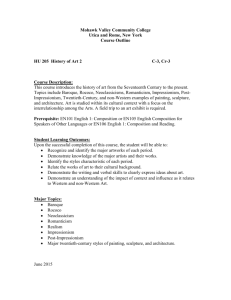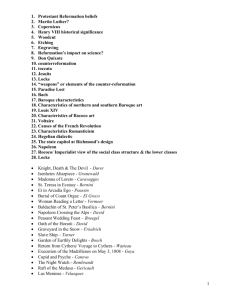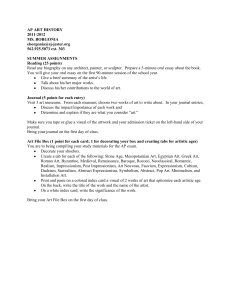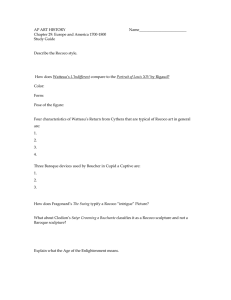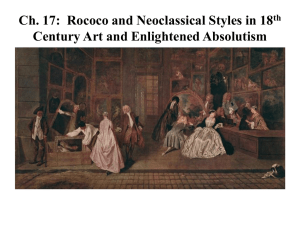Art Through The Ages
advertisement
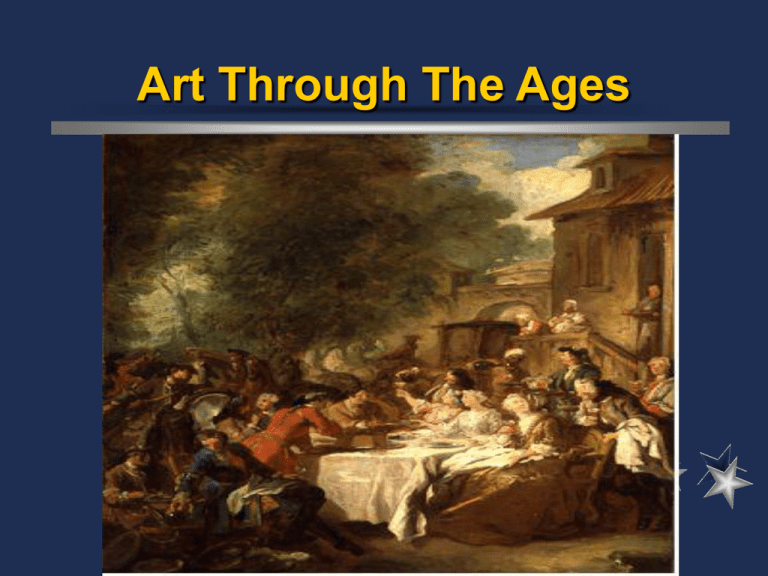
Art Through The Ages Medieval Art and Architecture Romanesque architectural style Many columns used to hold up the roofs of large buildings. Bright colors Items in pictures are not in proportion Mostly religious themes Rounded arches No rose windows Medieval Art Medieval Art Medieval Architecture Medieval Architecture Medieval Architecture Renaissance Art and Architecture Gothic architectural style Much more realistic Items pictured are in proportion Both secular and religious themes Blended colors, due to the use of tempura paints Pointed arches Flying buttresses & fewer columns Highly ornate detail Rose windows Renaissance Art Renaissance Art Renaissance Art Renaissance Art Renaissance Architecture Renaissance Architecture Renaissance Architecture Reformation Art Catholic reformation art was of the baroque style and was designed to impress an illiterate population with the glory and grandeur of the Catholic church. N. European reformation art was very plain and usually depicted every day life. – It is often referred to as the art of the Dutch Masters, such as Rembrandt and Hals. Reformation Art Reformation Art Reformation Art Baroque Art The desire to evoke emotional states by appealing to the senses, often in dramatic ways, underlies Baroque Art. Characteristics include grandeur, sensuous richness, drama, vitality, movement, tension, emotional exuberance, and often a natural background. Baroque Art Baroque Art Baroque Architecture Baroque Architecture Rococo Art The Rococo style in painting is decorative and non-functional, like the declining aristocracy it represented. Subjects are painted with wispy brushstrokes & the colors used often included luscious golds and reds. Its subject matter frequently dealt with the leisurely pastimes of the aristocracy and risqué love themes such as sensual intimacy, love, frivolity, & playful intrigue. Rococo art often looks fuzzy. (see examples) Rococo Art Characteristics of the Rococo style: Fussy detail Complex compositions Certain superficiality More ornateness Sweetness Light Playfulness Rococo Art Rococo Art Rococo Art Rococo Architecture Rococo Architecture Neoclassical Art Neoclassical Art is a severe, unemotional form of art harkening back to the style of ancient Greece and Rome. Its rigidity was a reaction to the overbred Rococo style and the emotional Baroque style. The rise of Neoclassical Art was part of a general revival of classical thought, which was of some importance in the American and French revolutions. Neoclassical Art Neoclassical Art Neoclassical Art Neoclassical Architecture Romanticism Romanticism can be seen as a rejection of the precepts of order, calm, harmony, balance, idealization, and rationality that typified late 18th-century Neoclassicism. It was also to some extent a reaction against the Enlightenment and against 18th-century rationalism and physical materialism in general. Romanticism emphasized the individual, the subjective, the irrational, the imaginative, the personal, the spontaneous, the emotional, the visionary, and the transcendental. Romanticism Romanticism Romanticism Impressionism The impressionist style of painting is characterized chiefly by concentration on the general impression produced by a scene or object and the use of unmixed primary colors and small strokes to simulate actual reflected light. The most conspicuous characteristic of Impressionism was an attempt to accurately and objectively record visual reality in terms of transient effects of light and color. Impressionism Impressionism Impressionism Pointillism Pointillism was a form of art that created pictures by combining a series of small dots. Seurat was one of the major artists of this school of painting. Seurat rejected the soft, irregular brushstrokes of impressionism in favor of pointillism, a technique he developed whereby solid forms are constructed by applying small, close-packed dots of unmixed color to a white background. Pointillism Pointillism Expressionism Expressionism is a style of art in which the intention is not to reproduce a subject accurately, but instead to portray it in such a way as to express the inner state of the artist. Many expressionist artists reflected their disillusion with modern society, especially in light of the two world wars. Expressionism Expressionism Cubism In Cubism the subject matter is broken up, analyzed, and reassembled in an abstracted form Cubists treat nature in terms of the cylinder, the sphere and the cone. Subjects in Cubists paintings are often hard to recognize. Cubism Cubism Cubism Surrealism style focuses on psychological states which resemble dreams and fantasy. artists were influenced by psychological research of Sigmund Freud and Carl Jung, who sought to explain the workings of the mind through analysis of the symbols of dreams saw the unconscious as a wellspring of untapped creative ideas Surrealism Surrealism
